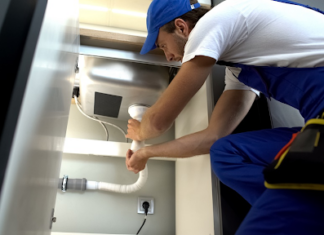Front-load washers, also called horizontal axis washers, are standard washing machine models in Europe. However, in countries like the United States, Australia, Canada, and beyond, front load washers are a matter of the recent past.
Many residents are curious about how front load washers can clean clothes with lesser detergent, no agitator, and little water.
So, let’s dive into the topic and find out how.
How Does A Front Load Washer work?
The top-load washers have been in the market for a long time, and they share similarities with the front load washers. Both machines have a stainless steel inner drum, control system, motor, drain pump, and rotational spinning technique. That’s where the similarities end.
In a typical front-load washer, a small amount of water is served to the inner drum. The machine achieves the washing motion using the water in the tub and gravity.
The motion of a front-load washer is similar to a clothes dryer. The side paddles continually move clothes in and out of the water, which achieves the scrubbing motion needed to eliminate dirt and oil from the clothes.
Since the rotational motion of the inner drum is in alignment with gravity, lesser water achieves more in front load washers. On the other hand, a top load washer rotational motion horizontally, requiring more water.
As front load washers use lesser water, detergent consumption is also less in households that have front load washing machines.
Water Usage
Front load washers have proved energy efficient in the last decade. A top-load washing machine consumes 26 gallons of water compared to a front-load washer, requiring not more than 13 gallons of water for every full load.
For a traditional household, a front-load washer saves thousands of gallons of water annually. Front load washers require a pre-set water level for every wash cycle, irrespective of how many clothes you add to the machine.
There will be scenarios where there are more clothes and less water to absorb by the clothes. In such cases, you can add more water while the tumbling action is ongoing. This will prevent any additional wastage of water.
Construction of Front Load Washers
The front-load washer has a simple construction which constitutes a motor connected to the drum through a pulley belt and wheel. A top load washer is comparatively more complex with gears and clutch systems.
Front-load washers have a flexible bellows system. Generally, rubber, to maintain the balance of the clothes input. As the owner, you must take utmost care of the machine as there are instances where small elements can enter through the gap between the basket, causing unnecessary clogs during drainage.
Front load washers also require stringent cleaning and maintenance, as the bellows tend to trap water in them, causing foul odour and mildew. So, you must keep a check on the bellows from time to time.
Many top models of the front-load washers allow users to add extra clothes or water while the wash cycle is ongoing. The door/latch system ensures that water or clothes don’t fall off when extra clothes or water is being added to the machine.
The control panels of the front load washers can be problematic at times. However, front load washers are an environment-friendly and more effective way of washing clothes through a machine.








